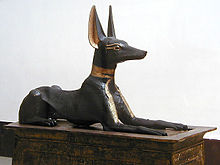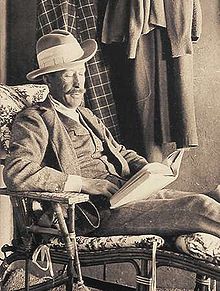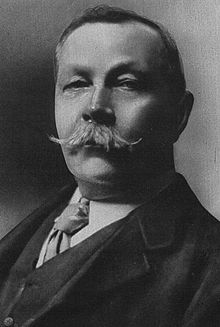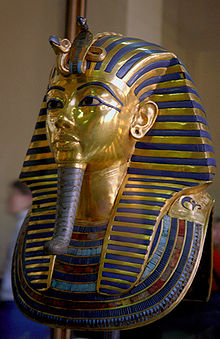- Curse of the pharaohs
-
- Pharaoh's Curse redirects here. For the video game, see Pharaoh's Curse (video game).
The curse of the pharaohs refers to the belief that any person who disturbs the mummy of an Ancient Egyptian pharaoh is placed under a curse.
There are occasional instances of curses appearing inside or on the facade of a tomb as in the case of the mastaba of Khentika Ikhekhi of the 6th dynasty at Saqqara. These appear to be more directed towards the ka priests to carefully protect the tomb and preserve ritual purity rather than a warning for potential robbers. Though there had been stories of curses going back to the nineteenth century, they multiplied in the aftermath of Howard Carter's discovery of the Tomb of Tutankhamun. There was no actual curse found in the Pharaoh's tomb.[1] The evidence for such curses relating to King Tutankhamun has been considered to be so meager that it is viewed as "unadulterated clap trap" by Donald B. Redford.[2]
Contents
Tomb curses
See also Execration Texts
Curses relating to tombs are rare, perhaps through the idea of such desecration being unthinkable and dangerous to record in writing.[1] They most frequently occur in private tombs of the Old Kingdom era.[3] The tomb of Ankhtifi (9-10th dynasty) contains the warning: "any ruler who... shall do evil or wickedness to this coffin... may Hemen [a local deity] not accept any goods he offers, and may his heir not inherit". The tomb of Khentika Ikhekhi (9-10th dynasty) contains an inscription: "As for all men who shall enter this my tomb... impure... there will be judgment... an end shall be made for him... I shall seize his neck like a bird... I shall cast the fear of myself into him".[1] Curses after the Old Kingdom era are less common though more severe in expression, sometimes invoking the ire of Thoth or the destruction of Sekhemet.[3] Zahi Hawass quotes an example of a curse: "Cursed be those who disturb the rest of a Pharaoh. They that shall break the seal of this tomb shall meet death by a disease that no doctor can diagnose."[4]
Modern accounts of curses
Hieroglyphs were not deciphered until the beginning of the 19th century by Jean-François Champollion so any reports of curses prior to this are in the domain of perceived bad luck associated with the handling of mummies and other artifacts from tombs. Louis Penicher wrote an account in 1699 in which he records how a Polish traveler bought two mummies in Alexandria and embarked on a sea journey with the mummies in the cargo hold. He was alarmed by recurring visions of two specters and stormy seas that did not abate until the mummies were thrown overboard.[1]
Zahi Hawass recalled that as a young archaeologist excavating at Kom Abu-Bellou he had to transport a number of artifacts from the Greco-Roman site. On the day he did so his cousin died, on the anniversary of that day his uncle died and on the third anniversary his aunt died. Years later when he excavated the tombs of the builders of the pyramids at Giza he encountered the curse: "All people who enter this tomb who will make evil against this tomb and destroy it may the crocodile be against them in water, and snakes against them on land. May the hippopotamus be against them in water, the scorpion against them on land." Though not superstitious, he decided not to disturb the mummies. However, he later was involved in the removal of two child mummies from Bahariya Oasis to a museum and subsequently reported how he was haunted by the children in his dreams. These phenomena did not stop until the mummy of the father was re-united with the children in the museum. He came to the conclusion that mummies should not be displayed though it was a lesser evil than allowing the general public into the tombs.[4] Hawass also recorded an incident relating to a sick young boy who loved Ancient Egypt and was subject to a "miracle" cure in the Egyptian Museum when he looked into the eyes of the mummy of King Ahmose I. Thereafter the boy read everything he could find on Ancient Egypt, especially the Hyksos period.[5]
The idea of a mummy's curse was developed in The Mummy!: Or a Tale of the Twenty-Second Century, an early work combining elements of science fiction and horror, written by Jane C. Loudon and published anonymously in 1827. Louisa May Alcott is thought to have been the first to use a "mummy curse" plot in her 1869 story "Lost in a Pyramid".[6]
Opening of King Tutankhamun's tomb
 The Anubis figure which guarded the entrance to Tutankhamun's treasury room.
The Anubis figure which guarded the entrance to Tutankhamun's treasury room.
The belief in a curse was brought to many people's attention due to the deaths of the members of the team of Howard Carter, who opened the tomb of Tutankhamun (KV62) in 1922, launching the modern era of Egyptology.
The famous Egyptologist James Henry Breasted worked with Carter soon after the first opening of the tomb. He reported how Carter sent a messenger on an errand to his house. On approaching his home he thought he heard a "faint, almost human cry". On reaching the entrance he saw the bird cage occupied by a cobra, the symbol of Egyptian monarchy. Carter's canary had died in its mouth and this fueled local rumors of a curse.[7] Arthur Weigall, a previous Inspector-General of Antiquities to the Egyptian Government, reported that this was interpreted as Carter's house being broken into by the Royal Cobra, the same as that worn on the King's head to strike enemies (see Uraeus), on the very day the King's tomb was being broken into.[8] An account of the incident was reported by the New York Times on the 22nd December 1922.[9]
 The death of Lord Carnarvon six weeks after the opening of Tutankhamun's tomb resulted in many curse stories in the press
The death of Lord Carnarvon six weeks after the opening of Tutankhamun's tomb resulted in many curse stories in the press
The first of the "mysterious" deaths was that of Lord Carnarvon. He had been bitten by a mosquito, and later slashed the bite accidentally while shaving. It became infected and blood poisoning resulted. Two weeks before Carnarvon died Marie Corelli wrote an imaginative letter which was published in the New York World magazine in which she quoted an obscure book that confidently asserted that "dire punishment" would follow an intrusion into a sealed tomb. A media frenzy followed with reports that a curse had been found in the King's tomb, but this was untrue.[3] Arthur Conan Doyle, the creator of Sherlock Holmes, suggested at the time that Lord Carnarvon's death had been caused by "elementals" created by Tutankhamun's priests to guard the royal tomb and this further fueled the media interest.[10] Arthur Weigall reported that six weeks before Carnarvon's death he had watched the Earl laughing and joking as he entered the King's tomb and his saying to a nearby reporter (H. V. Morton), "I give him six weeks to live."[11] The first autopsy carried out on the body of Tutankhamun by Dr Derry found a healed lesion on the left cheek, but as Carnarvon had been buried six months previously it was not possible to determine if the location of the wound on the King corresponded with the location of the fatal mosquito bite on Carnarvon.[12]
In 1925, the anthropologist Henry Field, accompanied by Breasted, visited the tomb and recalled the kindness and friendliness of Carter. He also reported how a paperweight given to Carter's friend Sir Bruce Ingham was composed of a mummified hand with its wrist adorned with a scarab bracelet marked with, "Cursed be he who moves my body. To him shall come fire, water and pestilence." Soon after receiving the gift, Ingram's house burned down, followed by a flood when it was rebuilt.[13]
Howard Carter was entirely skeptical of such curses.[14] He did report in his diary a "strange" account that in May 1926 he saw jackals of the same type as Anubis, the guardian of the dead, for the first time in over thirty-five years of working in the desert.[15]
Skeptics have pointed out that many others who visited the tomb or helped to discover it lived long and healthy lives. A study showed that of the 58 people who were present when the tomb and sarcophagus were opened, only eight died within a dozen years. All the others were still alive, including Howard Carter, who later died of lymphoma at the age of 64 in 1939.[16]
Possible causes
 Arthur Conan Doyle speculated in the press regarding the death of Lord Carnarvon so soon after opening of Tutankhamun's tomb
Arthur Conan Doyle speculated in the press regarding the death of Lord Carnarvon so soon after opening of Tutankhamun's tomb
Some have speculated that deadly fungus could have grown in the enclosed tombs and been released when they were open to the air. Arthur Conan Doyle favoured this idea, and speculated that the mold had been placed deliberately to punish grave robbers.
A newspaper report printed following Carnarvon's death is also believed to have been responsible for the wording of the curse most frequently associated with Tutankhamun – "Death shall come on swift wings to him who disturbs the peace of the King" – a phrase which does not actually appear among the hieroglyphs in KV62, even though it was said to appear in several different places.
While there is no evidence that such pathogens killed Lord Carnarvon, there is no doubt that dangerous materials can accumulate in old tombs. Recent studies of newly opened ancient Egyptian tombs that had not been exposed to modern contaminants found pathogenic bacteria of the Staphylococcus and Pseudomonas genera, and the moulds Aspergillus niger and Aspergillus flavus. Additionally, newly opened tombs often become roosts for bats, and bat guano may harbour histoplasmosis. However, at the concentrations typically found, these pathogens are generally only dangerous to persons with weakened immune systems.
Air samples taken from inside an unopened sarcophagus through a drilled hole showed high levels of ammonia, formaldehyde and hydrogen sulfide; these gases are all toxic, but are easily detected by their strong odours. Hydrogen sulfide is detectable at low concentrations (Up to 100PPM) beyond which it acts as a nerve agent on the olfactory senses. At 1000ppm it will kill with a single inhalation. [17]
The tomb was opened on November 29, 1922.
- Lord Carnarvon died on April 5, 1923 after a mosquito bite became infected. His death was 4 months, and 7 days after the opening of the tomb.[18][19]
- George Jay Gould I died in the French Riviera on May 16, 1923 after he developed a fever following a visit to the tomb.[20]
- Howard Carter opened the tomb on February 16, 1923 and died on March 2, 1939.[16]
- Prince Ali Kamel Fahmy Bey – Died 10 July 1923 – Shot dead by his wife.
- Colonel The Hon. Aubrey Herbert, MP, Carnarvon's half-brother – Died 26 September 1923 – Blood poisoning after dental procedure went wrong.
- South African millionaire Woolf Joel – Died 13 November 1923 – Death unexplained.
- Sir Archibald Douglas-Reid, Radiologist – Died 15 January 1924 – Serious Illness.
- Sir Lee Stack, Governor-General of Sudan – Died 19 November 1924 – Shot and assassinated whilst driving through Cairo.
- A. C. Mace, Egyptologist – Died 1928 – Arsenic poisoning[21]
- The Hon. Mervyn Herbert, Carnarvon's half brother – Died 26 May 1929 – Reported to have died of "malarial pneumonia".
- Captain The Hon. Richard Bethell, Carter's personal secretary – Died 15 November 1929 – Found smothered in his bed.
- Richard Luttrell Pilkington Bethell, 3rd Baron Westbury, Father of the above – Died 20 February 1930 – Supposedly threw himself off his seventh floor apartment.
- Edgar Steele, Director of handling Tomb Artifacts at the British Museum – Died 24 February 1930 – Blood poisoning after stomach procedure went wrong.
- Sir Ernest Budge, an Egyptologist and former Keeper of Egyptian Antiquities for the British Museum – Died 23 November 1934 – Found dead in his bed, death unexplained.
- James Henry Breasted, Egyptologist – Died December 2, 1935 – streptococcus after returning from Egypt.
- Prince Hallah Bey – Brother of Prince Ali – Committed sucicide.
- Hugh Evelyn-White, Egyptoloist – Commited sucide by hanging.
- A. C. Mace, Egyptologist – Died 1928 – Arsenic poisoning[22]
See also
- Cigars of the Pharaoh
- The Curse of King Tut's Tomb (1980 film)
- Curse of the Pharaoh: The Quest for Nefertiti
- Curse of The Mummy's Tomb
Bibliography
- "Howard Carter and the Discovery of the Tomb of Tutankhamun", H. V. F. Winstone, Constable, 1991, ISBN 0-09-469900-3
- "Mummies: Death and Life in Ancient Egypt", James Hamilton-Paterson Carol Andrews, p197, Collins, 1978, ISBN 0-00-195532-2
References
- ^ a b c d J. Paterson-Andrews, C. Andrews, p190
- ^ The Boy Behind the Mask, Charlotte Booth (quoting Donald B. Redford, p. xvi, Oneword, 2007, ISBN 978-1-85168-544-8
- ^ a b c Ancient Egypt, David P. Silverman, p146, Oxford University Press US, 2003, ISBN 019521952X
- ^ a b Valley of the Golden Mummies, Zahi A. Hawass, p94-97, American University Press in Cairo Press, 2000, ISBN 9774245857
- ^ "A born archeologist", Zahi Hawass, Al-Ahram Weekly, Feb 2004, retrieved 15 July 2009 [1]
- ^ Consuming Ancient Egypt, Sally MacDonald, Michael Rice, p26, University College, London. Institute of Archaeology, Routledge Cavendish, 2003, ISBN 1844720039
- ^ Winstone, p169
- ^ The Face of Tutankhamun, Christopher Frayling, p232, Faber & Faber, 1992, ISBN 0-571-16845-0
- ^ "Times Man Views Splendors of the Tomb of Tutankhamen", New York Times, December 22 1922, Retrieved 12th May 2009 [2]
- ^ J. Paterson-Andrews, C. Andrews, p196
- ^ Winstone, p262
- ^ "In the Valley of the Kings - Howard Carter and the Mystery of King Tutankhamun's Tomb", Daniel Meyerson,p. 158,Ballantine Books, 2009, ISBN 978-0-345-47693-7
- ^ Winstone, p265
- ^ J. Paterson-Andrews, C. Andrews, p198
- ^ Winstone, p266
- ^ a b David Vernon in Skeptical - a Handbook of Pseudoscience and the Paranormal, ed. Donald Laycock, David Vernon, Colin Groves, Simon Brown, Imagecraft, Canberra, 1989, ISBN 0731657942, p25
- ^ Egypt's "King Tut Curse" Caused by Tomb Toxins?
- ^ "Why we love mummies". Pittsburgh Tribune-Review. http://www.pittsburghlive.com/x/pittsburghtrib/living/movies/s_580209.html. Retrieved 2008-08-12. "Upon breaching the tomb, something stung Carnarvon on the cheek. He died several months later. Newspapers sensationalized his death as the fulfillment of an ancient mummy's curse. A rumor spread that there was an inscription over the tomb promising death to anyone who opened the tomb of the pharaoh. One recent theory is Carnarvon might have ingested anthrax spores deliberately placed in the tomb by ancient Egyptian priests to thwart tomb robbers."
- ^ "Carnarvon Is Dead Of An Insect's Bite At Pharaoh's Tomb. Blood Poisoning and Ensuing Pneumonia Conquer Tut-ankh-Amen Discoverer in Egypt.". New York Times. April 5, 1923. http://select.nytimes.com/gst/abstract.html?res=F20C11F7355416738DDDAC0894DC405B838EF1D3. Retrieved 2008-08-12. "The Earl of Carnarvon died peacefully at 2 o'clock this morning. He was conscious almost to the end."
- ^ "George J. Gould Dies in Villa in France.". New York Times. May 17, 1923. http://select.nytimes.com/gst/abstract.html?res=F00911FC3B5516738DDDAE0994DD405B838EF1D3. Retrieved 2008-05-23. "George Jay Gould died this morning at 3:30 o'clock at the Villa Zoralde, Cap Martin, where he had been living for some months with his wife and her two children. His death, it was stated at the villa, came quietly and was expected, as he had never rallied from the illness from which he had been suffering all Winter."
- ^ Rupert Furneaux, The World's Strangest Mysteries, (New York: Ace Books, 1961), p. 72-74.
- ^ Rupert Furneaux, The World's Strangest Mysteries, (New York: Ace Books, 1961), p. 72-74.
External links
Discovery Howard Carter • KV62 • MummyFamily Akhenaten (father) The Younger Lady (mother) Ankhesenamun (wife)Other Curse of the pharaohs • Exhibitions • Racial identityPopular culture Steve Martin song • Tutenstein • 1980 film • 2006 filmAncient Egyptian religion Mythology 


Deities Amun · Amunet · Anubis · Anuket · Apep · Apis · Aten · Atum · Bastet · Bat · Bes
Four sons of Horus · Geb · Hapi · Hathor · Heka · Heqet · Horus · Isis · Khepri
Khnum · Khonsu · Kuk · Maahes · Ma'at · Mafdet · Menhit · Meretseger · Meskhenet
Monthu · Min · Mnewer · Mut · Neith · Nekhbet · Nefertem · Nephthys · Nu · Nut · Osiris
Pakhet · Ptah · Qebui · Ra · Reshep · Satet · Sekhmet · Seker · Serket · Sobek
Sopdet · Sopdu · Set · Seshat · Shu · Taweret · Tefnut · Tatenen · Thoth · Wadjet
Wadj-wer · Wepwawet · WosretWritings Beliefs Categories:- Curses
- Pharaohs
- Egyptian mythology
Wikimedia Foundation. 2010.

